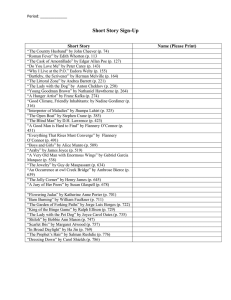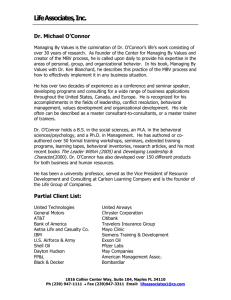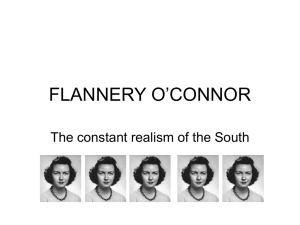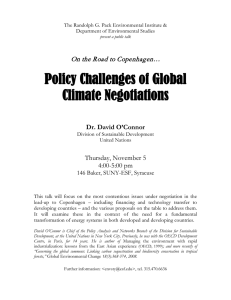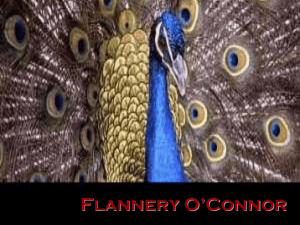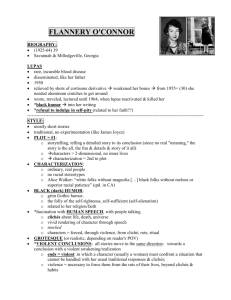Document 10466625
advertisement
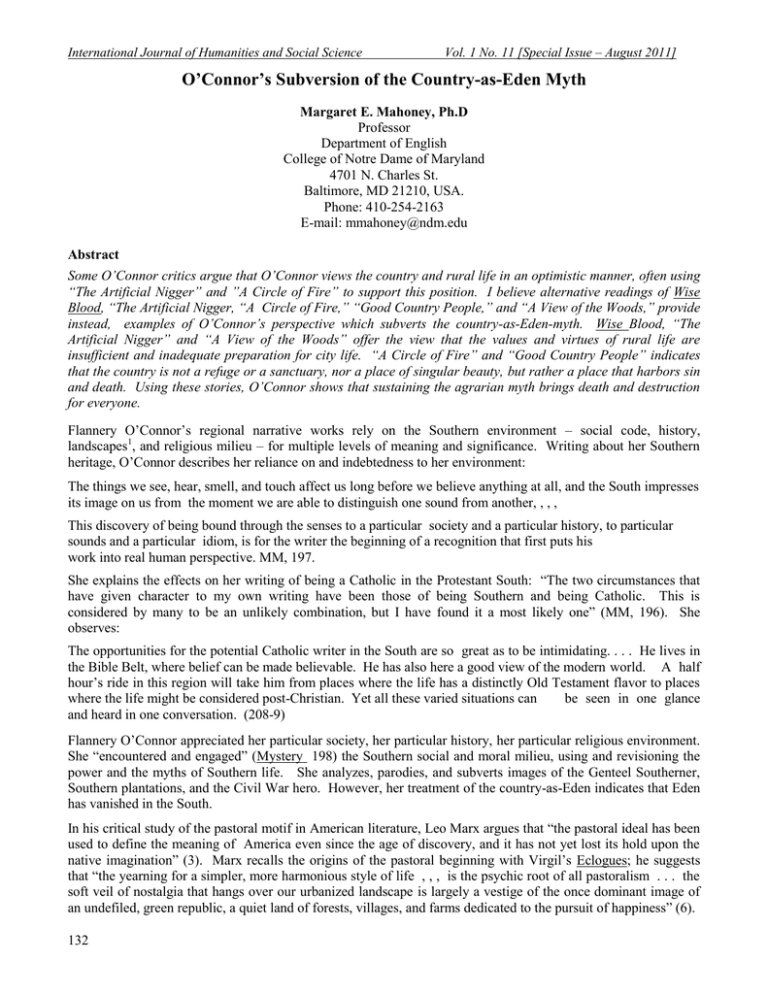
International Journal of Humanities and Social Science Vol. 1 No. 11 [Special Issue – August 2011] O’Connor’s Subversion of the Country-as-Eden Myth Margaret E. Mahoney, Ph.D Professor Department of English College of Notre Dame of Maryland 4701 N. Charles St. Baltimore, MD 21210, USA. Phone: 410-254-2163 E-mail: mmahoney@ndm.edu Abstract Some O’Connor critics argue that O’Connor views the country and rural life in an optimistic manner, often using “The Artificial Nigger” and ”A Circle of Fire” to support this position. I believe alternative readings of Wise Blood, “The Artificial Nigger, “A Circle of Fire,” “Good Country People,” and “A View of the Woods,” provide instead, examples of O’Connor’s perspective which subverts the country-as-Eden-myth. Wise Blood, “The Artificial Nigger” and “A View of the Woods” offer the view that the values and virtues of rural life are insufficient and inadequate preparation for city life. “A Circle of Fire” and “Good Country People” indicates that the country is not a refuge or a sanctuary, nor a place of singular beauty, but rather a place that harbors sin and death. Using these stories, O’Connor shows that sustaining the agrarian myth brings death and destruction for everyone. Flannery O’Connor’s regional narrative works rely on the Southern environment – social code, history, landscapes1, and religious milieu – for multiple levels of meaning and significance. Writing about her Southern heritage, O’Connor describes her reliance on and indebtedness to her environment: The things we see, hear, smell, and touch affect us long before we believe anything at all, and the South impresses its image on us from the moment we are able to distinguish one sound from another, , , , This discovery of being bound through the senses to a particular society and a particular history, to particular sounds and a particular idiom, is for the writer the beginning of a recognition that first puts his work into real human perspective. MM, 197. She explains the effects on her writing of being a Catholic in the Protestant South: ―The two circumstances that have given character to my own writing have been those of being Southern and being Catholic. This is considered by many to be an unlikely combination, but I have found it a most likely one‖ (MM, 196). She observes: The opportunities for the potential Catholic writer in the South are so great as to be intimidating. . . . He lives in the Bible Belt, where belief can be made believable. He has also here a good view of the modern world. A half hour’s ride in this region will take him from places where the life has a distinctly Old Testament flavor to places where the life might be considered post-Christian. Yet all these varied situations can be seen in one glance and heard in one conversation. (208-9) Flannery O’Connor appreciated her particular society, her particular history, her particular religious environment. She ―encountered and engaged‖ (Mystery 198) the Southern social and moral milieu, using and revisioning the power and the myths of Southern life. She analyzes, parodies, and subverts images of the Genteel Southerner, Southern plantations, and the Civil War hero. However, her treatment of the country-as-Eden indicates that Eden has vanished in the South. In his critical study of the pastoral motif in American literature, Leo Marx argues that ―the pastoral ideal has been used to define the meaning of America even since the age of discovery, and it has not yet lost its hold upon the native imagination‖ (3). Marx recalls the origins of the pastoral beginning with Virgil’s Eclogues; he suggests that ―the yearning for a simpler, more harmonious style of life , , , is the psychic root of all pastoralism . . . the soft veil of nostalgia that hangs over our urbanized landscape is largely a vestige of the once dominant image of an undefiled, green republic, a quiet land of forests, villages, and farms dedicated to the pursuit of happiness‖ (6). 132 The Special Issue on Arts and Social Science www.ijhssnet.com © Centre for Promoting Ideas, USA Well acquainted with the pastoral motif in American literature, Flannery O’Connor used it as a backdrop for her Georgia settings. Michael Cleary argues, Generally, O’Connor presents the country as a positive force, a superior environment to the city. She often accompanies this effect by portraying the country as a truly Edenic representation of a world of natural beauty, innocence, harmony, and isolation. At other times, the country becomes a refuge for suffering Man after the Fall. (21) Cleary uses Wise Blood, ―The Artificial Nigger,‖ ―Good Country People,‖ and ―A Circle of Fire‖ to illustrate his thesis 2 I believe alternative readings of these works and of ―A View of the Woods‖ provide instead, examples of O’Connor’s perspective which subverts the country-as-Eden myth. Two works, Wise Blood and ―The Artificial Nigger,‖ offer the view that the values and virtues of country life are insufficient and inadequate preparation for city life. Cleary suggests that in her novel, Wise Blood, O’Connor uses the country-as-Eden myth by viewing the country as a sanctuary from evil. A different reading might suggest that Haze Motes, the country bumpkin, is illsuited by his limited, country upbringing in Eastrod, Tennessee, to face the realities of small town living; he is most assuredly not prepared for the complexities of urban life. Country life has not prepared Haze for the simple task of crossing the street with the green light, much less for the difficulties of buying a used car. Enoch Emery, another country boy, deludes himself into believing he has adjusted to ―city‖ life in Taulkingham. With simple nostalgia for his country environment, Enoch3 believes the park to be ―the heart of the city. He has come to the city and---with a knowing in his blood---he has established himself at the heart of it.‖ (47). Neither Haze nor Enoch even understands that he has not adjusted to the city; neither returns to the country for sanctuary, relief, or moral refuge. In ―The Artificial Nigger,‖ Mr. Head does not even delude himself into believing he can manage the city and its complexities, given his country background. Great fears accompany him and his grandson as they travel toward the city. Mr. Head is anxious about the time of the train’s arrival, whether or not it will even stop for them, where to get on and off, and the most overwhelming fear—that of being lost in the myriad streets of the forbidding city. Cleary also suggests that the country is ―often the locale for a religious epiphany,‖ (24) but in this story, the city provides the place for Mr. Head’s and Nelson’s epiphanies and reconciliation. Two additional stories, ―Good Country People‖ and ―A Circle of Fire,‖ offer further examples of O’Connor’s subversion of the country-as-Eden myth. In ―Good Country People‖ Cleary reads Joy Hulga’s negative responses to her mother and to life on the farm as denials of her country roots. Rather the story seems a variation on the theme that the country is not a sanctuary and country life has not prepared one for the evils of city people. JoyHulga has been to the city, studied for years, and obtained her Ph.D., but O’Connor suggests Joy Hulga’s roots are so deeply embedded that even lengthy years of study in the city have neither supplanted nor altered her basic country beliefs. Ultimately, Joy-Hulga is her mother’s daughter, simple and trusting. Lacking both insight and moral vision, Joy-Hulga is unable to distinguish a good country person from a perverted con artist. ―A Circle of Fire‖4 also destroys the country-as-sanctuary image. Powell, one of the city boys, has come to the rural country side because of his father’s positive descriptions of its beauty and the hospitality of its people. Powell soon learns a different and sad lesson from Mrs. Cope, the matriarch of the farm. Her externally polite, but superficial attention to him, his friends, and their real needs, teaches him that the country is no refuge, no place of solace and comfort. In his anger and disappointment, Powell devises the plan to burn the woods, thereby literally and figuratively destroying the country-as-sanctuary. It is one of O’Connor’s stories from her second collection, however, that seems to epitomize her view of the country, not as a refuge, a sanctuary, or a place of singular beauty, but rather as a place that harbors sin and death. ―A View of the Woods‖ describes a middle-class family similar to the one in ―A Good Man is Hard to Find,‖ but in this story O’Connor’s emphasis lies more with the inherent dangers of economic well-being and profit-taking from the land rather than with the family’s social position. Written some years after ―A Good Man is Hard to Find,‖ ―A View of the Woods‖ shows O’Connor’s deep-seated concerns about indiscriminate economic progress, the consequent rise of middle-class families to greater levels of affluence, and the resulting internal family divisions. The members of the household are no longer humorously and genially described; instead domineering, cruel tendencies prevail. 133 International Journal of Humanities and Social Science Vol. 1 No. 11 [Special Issue – August 2011] Intergenerational problems are severe and irreconcilable, while economic gain and disregard for land and property become opportunities for manipulation and murder. O’Connor begins ―A View of the Woods‖ by drawing attention to Mary Fortune and ―the old man‖ driving his ―battered mulberry-colored Cadillac‖ (335); no endearing terms5 such as ―grandfather‖ or ―grandchild‖ appear in this story. Rather, O’Connor carefully signals the reader that the things used to establish the family’s economic position are also used to establish the distorted interpersonal relationships and intergenerational difficulties; the ―battered Cadillac‖ foreshadows both Mary Fortune’s relationship with her grandfather and their perilous endings. When the bulldozer runs the cow pasture into a ―square red hole,‖ O’Connor uses the incident to picture the fractured family: ―It happened to be the only pasture that Pitts (the old man’s son-in-law) had succeeded in getting the bitter weed off and when the old man had sold it, Pitts had nearly had a stroke‖ (335). Mr. Fortune appears intent on destroying all family bonds except the one between himself and his granddaughter. The Fortune/Pitts household consists of Mr. Fortune, his ―duty-proud kind‖ daughter, ―his third or fourth, (he could never remember which), her husband: thin, long jawed, irascible, sullen, sulking Pitts,‖ and their seven children ―all likewise idiots except the youngest Mary Fortune‖ (336). Obvious intergenerational difficulties exist because Mr. Fortune’s daughter and son-in-law are financially dependent on him; ―Pitts was the kind who couldn’t keep his hand on a nickel‖ (336), and the old man knows they are simply waiting for and wanting him to die. More subtle intergenerational difficulties exist between the old man and his granddaughter, and between Pitts and his daughter. Ostensibly, grandfather and grandchild are strongly bonded because Mary Fortune has ―his intelligence, his strong will, and his push and drive‖ (335), while father and daughter are apparently estranged because Pitts regularly beats her for insignificant reasons. The most obvious subversions of the country-as-Eden myth are, however, embedded in the understanding of the importance of and reverence for the land. Historically, land and property under gird the myth of the South; land and property indicate prosperous and ―proper‖ social and economic status. Mr. Fortune distorts the Southern tradition of property holding. In the name of progress he sells section after section of his land, dreaming not of large fields, abundant crops, and contented workers, but rather of a highway, new model cars, a supermarket, a gas station, a theater, and a motel. In ―A View of the Woods,‖ O’Connor uses the land as the pivotal force that divides the generations. Mr. Fortune owned eight hundred acres of land before he began selling off twenty-acre sections. Fortune comments to his granddaughter, Mary, about her parents: ―The Pittses are the kind that would let a cow pasture interfere with the future . . . but not you and me‖ (338). Mr. Fortune assumes incorrectly that Mary’s priorities are similar to his and unlike her parents’, who value the land and not technological progress. However, when Fortune announces to Mary that he intends to sell the land in front of their home, she protests. O’Connor quickly establishes a series of reasons that reveal Mary’s (and her parents’) appreciation for the land. For Mary, the land is her ―lawn,‖ her place to play, her opportunity to view the woods, and most importantly, the place where her father grazes the calves. To these insignificant, childish reasons, the grandfather replies, ―Do you think I give a damn hoot where that fool grazes his calves?‖ (342). Again, O’Connor raises the issue of respect, but this time she uses the child who says angrily, ―He who calls his brother a fool is subject to hell fire‖ (342), but the grandfather continues to misread the child’s deeply embedded respect both for the land and for her father. Not realizing the child’s defense is for her father, Fortune considers her outburst a sign that she is ―fearless and sturdy-minded‖ (343); he believes he needs only to give her a better example in order to make her even more like himself. The grandfather’s notion of a better example, however, means selling the land to promote progress. Unfortunately, when he views the land, as he does several times before he sells it, Fortune sees neither the extrinsic beauty, not the intrinsic value. Rather he sees only ―woods—not a mountain, not a waterfall . . . [only] thin pine trunk(s) . . . . A pine trunk is a pine trunk‖ (348), he says. Fortune’s narrow vision of the land is as narrow as his vision of wealth and progress. To him, progress means ―the road would soon be paved. . . . Travelers from all over the country would stop at Tilman’s‖ (348). He believes Tilman’s country store and the gas station constitute a Georgia metropolis, and only he has had the foresight to plan ahead for this metropolis. Fortune’s notions of progress clearly indicate how little he understands about the future, his granddaughter, or the land. Away from the land, away from the ―lawn‖ that had been sold, O’Connor places the final grim scene of the narrative. Fortune, humiliated by Mary’s outrageous temper and bad behavior over the land sale, decides ―he could no longer avoid whipping her‖ (353). 134 The Special Issue on Arts and Social Science www.ijhssnet.com © Centre for Promoting Ideas, USA He mistakenly believes that ―Mary respected Pitts [her father] because, even with no just cause, he beat her‖ (353). As Fortune prepares to punish her, Mary becomes ―pure Pitts‖ and pummels the seventy-nine-year-old man to the ground. Enraged by her defiant behavior and insulting remark, Fortune ―looks down into the face that was his own but had dared to call itself Pitts‖ (355) and crushes Mary’s head against the rock. His own heart condition worsens, and his last view is of the monstrous machine ―gorging itself on clay‖ (356) and destroying the land. In ―A View of the Woods‖ O’Connor challenges both the Southern sense of reverence for the land and the country-as-Eden motif by inverting the mythical assumptions. The seventy-nine-year-old grandfather praises the notions of urban progress embodied in gas stations and paved roads, while the nine-year-old granddaughter believes in the agrarian life and the necessity of farming the land. O’Connor subverts the country as refuge and sanctuary through multigenerational levels of misunderstanding, contempt, and lack of respect. Ultimately she shows that sustaining the agrarian myth brings death and destruction. NOTES C. Hugh Holman describes O’Connor’s South—its geography, groups of people, and famous writers who have chronicled its past and present. He views O’Connor’s South as ―special . . .remote from the moss-draped melancholy great oaks and the stable social order of the Atlantic seaboard and equally distant from the tropical lushness and piedmont Georgia and eastern Tennessee—a rolling, sparsely wooded land where both the spring freshlets and the ravishing plow pierce its surface to leave gaping wounds of dark, red clay. It is cotton country, made up of small farms, small towns, and widely-spaced small cities—a country at the mercy of capricious weather and the vicissitudes of the cotton market, which has been in a fluctuating states but one that has always remained depressed since the 1920s‖ (74-75). 2 Additionally, Cleary argues in ―Environmental Influences in Flannery O’Connor’s Fiction‖, that the country is both Eden and sanctuary, the city is inherently evil, corrupting all who live or venture there, and that city people express enmity toward country people and the country itself. 1 All references to Flannery O’Connor’s stories are from The Collected Works, Farrar, Strauss, and Giroux. 3 David Eggenschwiler suggests that ―A Circle of Fire‖ illustrates OConnor’s concept of persons who are neurotic and also have demons. Demonic, for O’Connor, means ―A worship of what is not God‖ (67), a worship of idols wuch as one’s farm or one’s social class. 4 5 Claire Katz notes that independence and aggression are childhood issues in this story and are complicated by the unresolved relationship to a father figure. 6 John May insists that the story demands a mythical or an allegorical interpretation because of the ―Edenic complications of the forest‖ (104). References Cleary, Michael. ―The Environmental Influences in Flannery O’Connor’s Fiction.‖ Flannery O’Connor Bulletin 8 (1979): 20-34. Eggenschweiler, David. The Christian Humanism of Flannery O’Connor. Detroit: Wayne State UP, 1972. Holman, C. Hugh. ―Her Rue with a Difference.‖ The Added Dimension: The Art and Mind of Flannery O’Connor. Eds. Melvin Friedman and Lewis Lawson. New York: Fordham UP, 1966. 73-87. Katz, Claire. ―Flannery O’Connor’s Rage of Vision.‖ American Literature 46: 54-67. Marx, Leo. The Machine in the Garden: Technology and the Pastoral Ideal in America.New York: Oxford, 1964. May. John. The Pruning Word: The Parables of Flannery O’Connor. U of Notre Dame P, 1976. O’Connor, Flannery. The Complete Stories. New York: Farrar, 1972. ---. Mystery and Manners. New York: Farrar, 1972. 135
